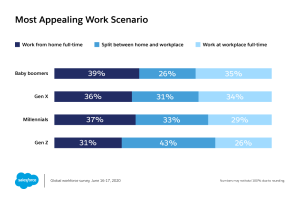New Survey Data Shows Possible Scenarios for the Future of Offices, Commuting, and Cities



Every two weeks, Salesforce Research is surveying the general population to discover how consumers and the workforce are navigating the COVID-19 pandemic. We’re posting the insights we’ve found, and tips on what businesses can do in response.
Click here to explore data across demographics and geographies.
As businesses, governments, and cities are all in different phases of reopening, they are all in a constant state of evaluating what’s safe, what’s not, and what the next weeks, months, and years will look like.
To gain a pulse check on how workers view the prospect of returning to some semblance of normalcy — and what their employers and the transit agencies many rely on can do to keep them safe, calm, and productive — we analyzed our latest general population survey of over 3,500 individuals worldwide. Here’s an overview of what we found.
The role of workplaces is changing, not disappearing
An earlier wave of our survey found a majority of the workforce working remotely — mostly for the first time — and high interest in extending such arrangements for the long term. Our latest data show that while workers are questioning whether a daily commute to a central location is truly necessary, they aren’t necessarily looking to abandon their traditional workplaces completely.
Just 37% of our survey respondents view full-time remote work as the most appealing long-term scenario. In contrast, 64% want to spend at least some of their working hours at an office, store, factory, or other type of workplace. Gen Z, which will soon become the largest segment of the workforce, is particularly interested in a “hybrid” approach in which time is split between home and the workplace.

Just 32% of workers expect their employers to reduce or eliminate their real estate footprints.
Reopening preparedness and tactics vary by sector and setting
With formal workplaces set to have a continued presence, businesses are challenged to plan and implement strategies for bringing staff back and keeping them safe. Given the unprecedented nature of the pandemic and lack of standardized guidelines, many businesses are struggling with the question of how to reopen.
Workers are well aware of the lack of strategy, with 45% of respondents agreeing that their employer is ready to bring staff back to the workplace, and 43% saying they’ve been given clear communication on a reopening plan. There are large gaps in perceptions among respondents who provided their industry, with life sciences and biotechnology workers particularly wary of their employers’ plans and financial services employees expressing relative comfort and clarity in their situations.

Businesses of all types face complex, multi-faceted reopenings. When segmented by workplace environment, our survey finds commonalities and differences between what can make office, factory, and retail workers feel safe. Enhanced cleaning and reduced capacity are pillars of any reopening strategy, according to our respondents. Office workers put particular emphasis on contact tracing, whereas factory and retail workers are partial to daily wellness checks.

52% of workers say they’re comfortable sharing personal information like health data and contacts to keep the workplace safe. Millennials are the most willing (59%) whereas baby boomers are the least willing (40%).
Personal and family circumstances present a barrier to young and low-income workers
All workers face challenges as workplaces reopen — including fears around the building experience they’ll come back to, the risk of being exposed to sick co-workers, and how productive they can be in a radically different environment. Low income and younger workers, however, are more likely to have personal circumstances such as childcare or eldercare that complicate their path forward.
70% of Gen Z workers and 68% of millennial workers, for example, are at least moderately concerned about their family or personal circumstances when returning to work, compared to 35% of baby boomers. Such concern is also more acute among lower income workers, who are 11 percentage points more likely than their higher income counterparts to voice such anxieties.
Compounding their fears, low income workers are also less likely to say they have the space to work from home long term (42%) than high income workers (59%).

Commuting is changing, but in ways we may not assume
After hard fought campaigns to reduce congestion and emissions by incentivizing mass transit, metropolitan areas face a future in which plummeting ridership could struggle to recover. Our survey suggests that the share of commuters using mass transit commutes will fall 29% — from 24% of commuters to 17% — when they return to their workplaces.
Despite predictions of a looming “carpocalypse” descending on cities as virus-wary commuters isolate in their own cars, our survey respondents say they’re planning to utilize a variety of transportation methods. The share of single car commuters is expected to tick up from 60% to 61% — hardly accounting for the predicted decline in transit ridership. Commuters also have plans to increase their use of carpools or rideshares, scooters and motorcycles, and walking.

Transit agencies will need a multifaceted approach to rebuild trust
67% of the workforce is at least moderately concerned about commuting when they return to work during the pandemic, a figure that rises to 81% among those who previously commuted by public transit. To placate rider concerns and rebuild boarding numbers, transit agencies will need to combine operational updates, including increased frequency and capacity with new protocols like required face coverings on top of enhanced cleaning measures.
















